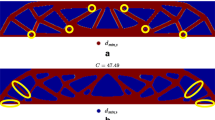Abstract
The ability to control both the minimum size of holes and the minimum size of structural members are essential requirements in the topology optimization design process for manufacturing. This paper addresses both requirements by means of a unified approach involving mesh-independent projection techniques. An inverse projection is developed to control the minimum hole size while a standard direct projection scheme is used to control the minimum length of structural members. In addition, a heuristic scheme combining both contrasting requirements simultaneously is discussed. Two topology optimization implementations are contributed: one in which the projection (either inverse or direct) is used at each iteration; and the other in which a two-phase scheme is explored. In the first phase, the compliance minimization is carried out without any projection until convergence. In the second phase, the chosen projection scheme is applied iteratively until a solution is obtained while satisfying either the minimum member size or minimum hole size. Examples demonstrate the various features of the projection-based techniques presented.
Similar content being viewed by others
References
Bendsøe MP (1989) Optimal shape design as a material distribution problem. Struct Optim 1(4):193–202
Bendsøe MP, Sigmund O (2003) Topology optimization: theory, methods and applications. Springer, New York
Borrvall T, Petersson J (2001) Topology optimization using regularized intermediate density control. Comput Methods Appl Mech Eng 190(37):4911–4928
Bourdin B (2001) Filters in topology optimization. Int J Numer Methods Eng 50(9):2143–2158
Carbonari RC, Silva ECN, Paulino GH (2007) Topology optimization design of functionally graded bimorph-type piezoeletric actuators. Smart Mater Struc 16(6):2605–2620
Carbonari RC, Silva ECN, Paulino GH (2009) Multi-actuated functionally graded piezoelectric micro-tools design: a multiphysics topology optimization approach. Int J Numer Methods Eng. doi:10.1002/nme.2403
Chang K-H, Tang P-S (2001) Integration of design and manufacturing for structural shape optimization. Adv Eng Softw 32(7):555–567
Guest JK (2009) Imposing maximum length scale in topology optimization. Struct Multidisc Optim. doi:10.1007/s00158-008-0250-7
Guest JK, Prévost JH, Belytschko T (2004) Achieving minimum length scale in topology optimization using nodal design variables and projection functions. Int J Numer Methods Eng 61(2):238–254
Guo X, Gu YX (2004) A new density-stiffness interpolation scheme for topology optimization of continuum structures. Eng Comput 21(1):9–22
Ishii K, Aomura S (2004) Topology optimization for the extruded three dimensional structure with constant cross section. JSME Int J, Series A, 47(2):198–206
Matsui K, Terada K (2004) Continuous approximation for material distribution for topology optimization. Int J Numer Methods Eng 59(14):1925–1944
Nitsopoulos I, Lauber B (2007) Overview on optimization methods, FE-DESIGN GmbH, TOSCA Structure. ANSA and META International Congress, June 14–15,2002. http://www.fe-design.com
Rozvany GIN (2001a) Topology optimization in structural mechanics. Editorial. Struct Multidisc Optim 21(2):89
Rozvany GIN (2001b) Aims, scope, methods, history and unified terminology of computer-aided topology optimization in structural mechanics. Struct Multidisc Optim 21(2):90–108
Sigmund O (1997) On the design of compliant mechanisms using topology optimization. Mechan Struct Mach 25(4):493–524
Sigmund O (2001) Design of multiphysics actuators using topology optimization—part II: two-material structures. Comput Methods Appl Mech Eng 190(49–50):6605–6627
Sigmund O (2007) Morphology-based black and white filters for topology optimization. Struct Multidisc Optim 33(4–5):401–424
Wang MY, Wang S (2005) Bilateral filtering for structural topology optimization. Int J Numer Methods Eng 63(13):1911–1938
Zhou M, Rozvany GIN (1991) The COC algorithm, part II: topological, geometry and generalized shape optimization. Comput Methods Appl Mech Eng 89(1):197–224
Zhou M, Shyy YK, Thomas HL (2001) Checkerboard and minimum member size control in topology optimization. Struct Multidisc Optim 21(2):152–158
Zuo K-T, Chen L-P, Zhang Y-Q, Yang J (2006) Manufacturing- and machining-based topology optimization. Int J Adv Manuf Technol 27(5–6):531–536
Author information
Authors and Affiliations
Corresponding author
Rights and permissions
About this article
Cite this article
Almeida, S.R.M., Paulino, G.H. & Silva, E.C.N. A simple and effective inverse projection scheme for void distribution control in topology optimization. Struct Multidisc Optim 39, 359–371 (2009). https://doi.org/10.1007/s00158-008-0332-6
Received:
Revised:
Accepted:
Published:
Issue Date:
DOI: https://doi.org/10.1007/s00158-008-0332-6




